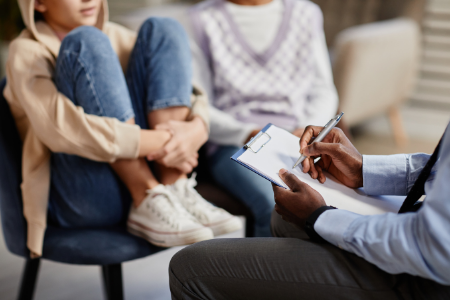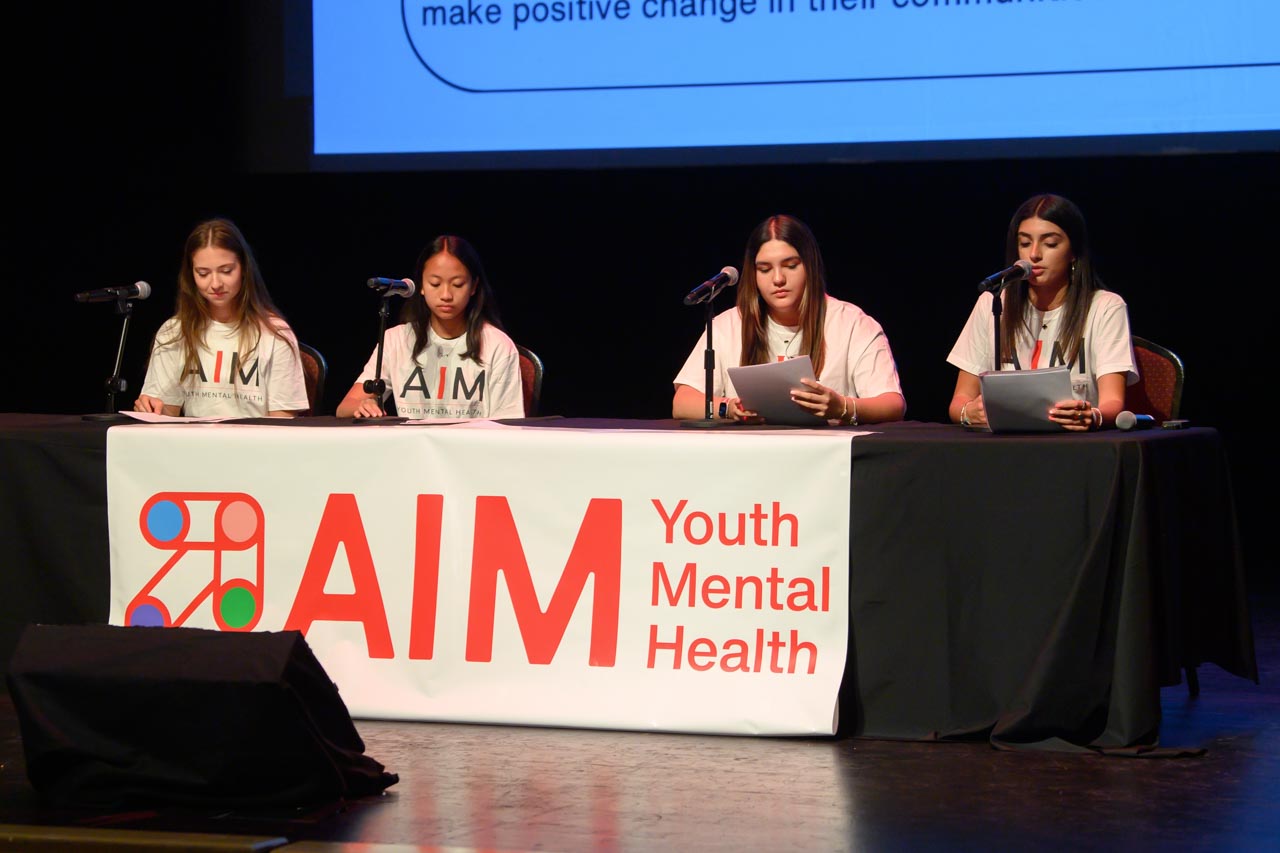A new approach to treating early symptoms of severe mental illness in teens holds promise for prevention.
By Jill Suttie
“James” is a high schooler who was experiencing strange thoughts that worried him and his parents. He suspected that people around him might be reading his mind and judging him. He avoided his peers, isolating himself and suffering from anxiety and depression. He rarely left home and ended up needing homeschooling.
 “Sandra”, another teen, experienced several bouts of depression, which made her feel hopeless, guilty, and ashamed. She became reluctant to get out of bed. Sometimes, her mood swung wildly the other way, and she’d be filled with energy and immerse herself in multiple activities, which exhausted her.
“Sandra”, another teen, experienced several bouts of depression, which made her feel hopeless, guilty, and ashamed. She became reluctant to get out of bed. Sometimes, her mood swung wildly the other way, and she’d be filled with energy and immerse herself in multiple activities, which exhausted her.
This is what early symptoms of psychosis or bipolar disorder can look like in adolescence. And, it’s worrying to afflicted kids and parents alike.
Luckily, not every teen who experiences symptoms like these goes on to develop a serious mental problem. But, some do. About a third of teens at risk for psychosis or bipolar disorder develop a full-blown syndrome within three-four years. So, it’s important to identify kids needing treatment while their symptoms are less chronic and help them find relief in the present, while avoiding more serious problems later on.
That’s where Marc Weintraub’s research comes in. Weintraub, a researcher at the UCLA Semel Institute of Neuroscience and Human Behavior and AIM grant recipient, has been studying ways to address the problematic thoughts, feelings, and behaviors that plague kids like James and Sandra. By developing and testing a “trans-diagnostic” treatment protocol that targets their troubling symptoms, he hopes to catch teens before things devolve further.
“If we can teach more generalized principles and skills to teens to help them with a wide variety of different presenting conditions, we could get more bang for our buck and reach a broad audience, no matter their potential diagnosis,” says Weintraub.
What it looks like if your teen is at risk
All adolescents can be a bit moody at times, sometimes experiencing wild swings of emotion. They sometimes suffer anxiety as they face increasing academic challenges and more complicated social interactions. And, they may pull away some from their parents, seeking more privacy and being more internal than when they were younger.
How is a parent to know whether any of this is particularly problematic?
Weintraub suggests parents first consider how pervasive these feelings and behaviors are. For example, if your child is just isolating at home, it’s less worrying. But, if they isolate themselves at school, foregoing activities they used to love or avoiding their friends, that might warrant paying more attention
Parents should also consider whether their child’s problems seem to continue over time, he says. Any person can have a bad day or a bad week; but you might consider that your teen has more severe issues if their troubling moods last for weeks or months on end.
On the other hand, there’s more cause for concern if your teen is having weird, unusual thoughts or behaving very strangely, says Weintraub. For example, hearing voices or seeing things that aren’t there or experiencing delusions should be checked out by a professional.
Unfortunately, Weintraub says, many teens will hide symptoms like those from the people around them, including parents, because of the stigma attached to them. Even a low mood is sometimes hard for parents to detect, as teen depression can look more like anger or irritability.
“Teens aren’t always telling parents what’s going on,” says Weintraub. “It’s more often a mood, anxiety, withdrawal, and functional impairments that parents are commonly able to see.”
Unified treatment for kids at risk of severe mental illness
But, there’s good news for parents of kids experiencing these problems: Weintraub’s treatment protocol. Drawn mostly from cognitive-behavioral therapy for depression and anxiety, the therapy is designed to teach teens about the relationship between their thoughts, feelings, and behaviors and to give them skills for soothing difficult feelings, challenging distorted thoughts, and trying out alternative ways of approaching their problems.
For example, if teens have a troubling thought—like, None of my friends ever wants to talk to me; no one cares about me—a therapist can show them why that thought is likely distorted (all or nothing thinking) and how carrying that thought affects their feelings (sad, anxious) and behavior (avoiding friends). Then, the teens can learn ways to challenge distorted thoughts using “detective thinking”—perhaps recalling a time when a friend did listen and express care.
The treatment modules also teach teens breathing techniques to calm down and how to challenge behaviors that are self-defeating (like, avoiding friend) by doing the opposite behavior (approaching friends even though you’re worried they won’t listen). By offering a number of different strategies, the therapy can be somewhat tailored to an individual teen.
For Sandra, many elements helped her manage symptoms. Using the breathing exercises calmed her anxiety, while learning to think more flexibly and approach (rather than avoid) doing her homework helped lessen her mood swings, helping her function better and improving her enjoyment of life.
To engage teens like her and James and help them feel less alone in their challenges, the treatment is offered in a group format. During each weekly session, teen groups meets with a therapist to learn about their inner lives and develop new skills At the same time, parents meet separately to hear about the curriculum, then join the teens to hear what they’ve learned and negotiate how they’ll practice skills between sessions.
Weintraub believes that having teens share their emotional challenges with their parents is crucial for success. That’s why communication skills are added to the treatment, too.
“Whether it’s true or not, teens commonly feel like it’s hard for them to be heard, that their parents are not always willing or able to listen,” he says. “The more parents can practice being as good listeners as possible, the better it is for their relationship with their teens.”
Weintraub also included a mindfulness exercise in the treatment that involves teens learning to accept whatever is happening in the present moment without judgment. That may seem counterintuitive, given the treatment focus on kids changing their thoughts and feelings. But, Weintraub says sometimes cognitive behavioral therapy doesn’t work for every situation, and it’s good to have multiple tools at kids’ disposal. Plus, there are sometimes harsh realities that have to be faced or some particular perceptual abnormalities that are hard to change, even with effort.
“Once we work through some of the cognitive skills—identifying unhelpful thoughts and trying to modify them—maybe we end up identifying things that are just not so modifiable,” he says. “What could be another alternative? We can pivot into a mindfulness approach.”
Mindfulness certainly helped James. After applying detective thinking to his troubling thoughts, he still found it hard sometimes to let them go, keeping him stuck. But, learning how to accept his troubling thoughts as “just thoughts” through mindfulness loosened their grip on him, allowing him to move forward.
What’s next for Weintraub’s research
Individual stories like these suggest that Weintraub’s program is helping, but more research needs to be done to prove it’s effective. To that end, he’s about to publish results from a recent study with a larger group of teens showing they made significant gains after going through the therapy.
“The upshot is actually really encouraging,” he says. “Mood symptoms and prodromal symptoms [like, unusual thoughts or unusual mood swings] were improved through the course of the treatment from baseline.”
In addition, this study tested out if using an phone app could encourage teens to complete more homework assignments between sessions, which should improve the therapy’s effectiveness. Some teens were assigned to use the app, which pinged them twice a week and reminded them to practice the new skills, while others just did the usual therapy. So far, the app appears to be a promising addition to treatment.
“The more that the teens use their app, the greater their improvements in mood and in function,” says Weintraub.
By continuing to plug away at this research, Weintraub hopes to find a treatment program that is acceptable to teens and effective at preventing more serious mental illnesses from developing. If this approach works, he will be disseminating it as widely as possible, to get it out to the teens who need it.
“By virtue of it being trans-diagnostic and broad based in principles and the skills taught, it has the potential to be very useful—almost regardless of what difficulties these teens face,” he says.
______________________
About the Author
Jill Suttie, Psy.D., is a free-lance journalist and a staff writer and contributing editor for Greater Good, an award-winning online magazine published by the University of California’s Greater Good Science Center. A psychologist by training, her articles cover scientific research aimed at uncovering the keys to individual wellbeing and a more compassionate society. She also records music and has two CD’s of original songs that can be heard and purchased on her personal website: jillsuttie.com.





